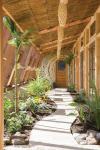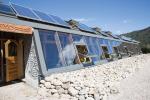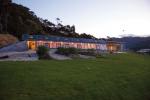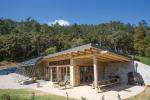In the beginning . . . there was earth, rain and sun
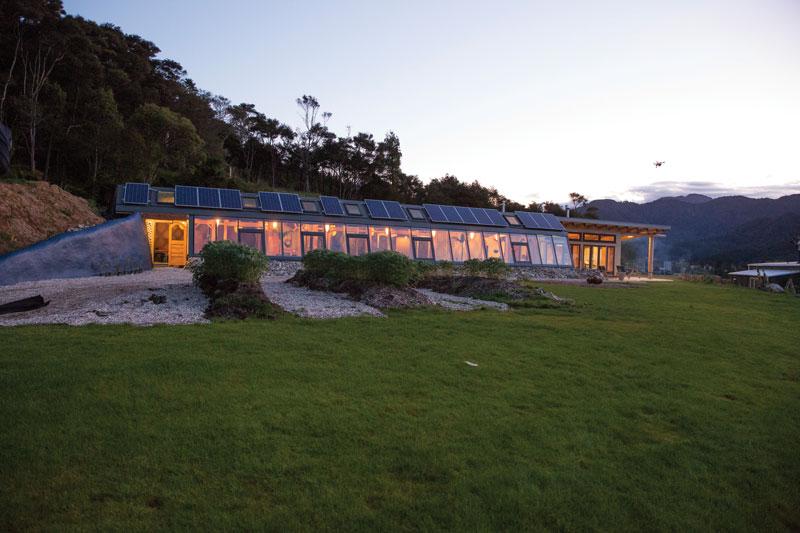
“Earthship Te Timatanga’s first power bill: in credit!”
So declares Sarah Rowe, partner of Gus Anning, in a November 2015 entry on Facebook, marking yet another step toward the couple’s bid to be self-sustaining in their ‘Earthship’.
The concept was created and developed in the 1970s by American architect, Michael Reynolds who named the method ‘Biotecture’ and the design ‘Earthship’ and defined Earthship as a building that conforms to principles of self-sustainability: a self-contained, impact-minimising, land-based ‘ship’ designed to work in harmony with the environment – and a statement against mass consumerism.
Located near Tairua in the Coromandel, New Zealand’s most recently constructed ‘Earthship’, Te Timatanga (’the beginning’) qualifies in all respects. Made from recycled materials (notably mud bricks, 7000 glass bottles and 1300 recycled tyres rammed full of earth), this off-the-grid Earthship collects and recycles its own water, contains its own sewage, grows much of the family’s food and, through a combination of active solar heating and thermal mass construction, also generates its own energy.
A low-slung, single-storeyed building consisting of four bedrooms, a bathroom, and an open-plan kitchen and living room, Earthship Te Timatanga is imbedded in the hillside behind it while its north-facing wall, which fronts an atrium, is entirely of glass and so maximises the sun’s warmth while also reflecting the ever-changing images of the sky.
During the day the sun’s energy is absorbed into the tyre walls and stored within a thermal capacitor created by the shawl of banked earth wrapped round three sides of the building. As the air cools, the thermal energy is released, thus naturally maintaining a consistent temperature. Whilst the atrium ‘super-heats’ in the sun to create a power source for storing within the rammed-mud tyre walls, strategically positioned natural ventilation circulates air and ensures comfortable room temperatures throughout the home through all seasons regardless of weather conditions.
Plants not only thrive within the atrium, they provide both food and shade for this Earthship family. Interior walls are constructed of mudbricks and light earth building techniques. Gus and Sarah have also utilised glass bottles to harness natural light into the house. The walls light up like jewels in the evening sun.
Huge logs support the roof which, according to Earthship specifications, can be covered in any material that is suitable for capturing water. The water drains into cisterns from where it is filtered and stored, to be used for drinking, cooking and cleaning. After first use it becomes ‘grey water’ and is filtered and fed to the plants. Surplus grey water goes to the toilet cistern from which the ‘black water’ is flushed into a natural-flow wormorator. Eventually, when sufficiently broken down, it gravity- feeds through a drainage field to fertilise the stone fruit orchard beyond.
For their roofing, Gus and Sarah chose Insulated panel longrun COLORSTEEL , ‘thunder grey’ in colour to blend with the distant, sometimes hazy Coromandel mountains and the dusky manuka bush surrounding their valley – and they chose Metalcraft Roofing Ltd to supply and install it.
“We particularly liked that Metalcraft is a ‘one-stop shop’,” says Gus. “They installed their insulated sandwich panel system on the roof, fitted the appropriate flashings and also supplied the PV solar panels.” (In this case, a 4.25kW array consisting of 17 x 2.5KW solar panels, each with its own micro- inverter). Interspersed with the adjustable ventilation apertures, the panels are attached to the strip of north-facing roof running the length of the house.
“Coupled with the design’s thermal efficiency, the insulated roofing panels and energy generated by the solar panels, Earthship Te Timatanga works fantastically, with little fluctuation in the temperature of around 17- 20ᴼC. Despite having three frosts shortly after we moved in, in early October, we enjoyed a comfortable 15ᴼ inside while outside it was -1ᴼC and the glazing was iced up.
“We generate more power than we use and expect a daily export to the national grid of between 2.5 and 3.2 kWh (kilowatt hours) , amounting to a serious credit over the years – hence Sarah’s jubilant announcement.”

